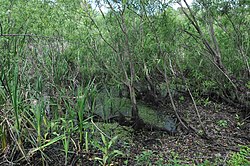Windover Archeological Site | |
 | |
| Location | Brevard County, Florida |
|---|---|
| Nearest city | Titusville[2] |
| Coordinates | 28°32′25″N 80°50′35″W / 28.54028°N 80.84306°W |
| Area | 1.3 acres (0.53 ha) |
| NRHP reference No. | 87000810[1] |
| Significant dates | |
| Added to NRHP | April 20, 1987[1] |
| Designated NHL | May 28, 1987[2] |
The Windover Archeological Site is a Middle Archaic (8,000 to 1,000 BC) archaeological site and National Historic Landmark in Brevard County near Titusville, Florida, United States on the central east coast of the state. Windover is a muck pond where skeletal remains of 168 individuals were found buried in the peat at the bottom of the pond. The skeletons were well preserved because of the peat. In addition, remarkably well-preserved brain tissue has been recovered from 91 skulls from the site. DNA from the brain tissue has been sequenced. The collection of human skeletal remains and artifacts recovered from Windover Pond represent among the largest finds of each type from the Archaic Period. It is considered one of the most important archeological sites ever excavated.
The Windover dig site is a small pond, about 1⁄4 acre (1,000 square meters) in area, that has held water continuously since sometime between 9000 and 8000 BC. It is next to the Atlantic Coastal Ridge about 5 miles (8 km) from Cape Canaveral. As the sea level was considerably lower 7,000 to 8,000 years ago than it is today, the pond originally sat above the water table, and was filled only by rainfall and runoff from the surrounding land. At that time the pond had a relatively thin layer of peat under a thin layer of water. The subsequent rise in sea level raised the local water table and in more recent times the pond has been fed by groundwater as well as rainfall. In 1984, the pond had a thick layer of peat, with five strata described by the archaeologists who excavated the pond. The peat in the center of the pond was covered by 6 feet (2 m) of water.[3]
- ^ a b "National Register Information System". National Register of Historic Places. National Park Service. July 9, 2010.
- ^ a b "Windover Archeological Site". National Historic Landmark summary listing. National Park Service. Archived from the original on May 2, 2009. Retrieved June 21, 2008.
- ^ Milanich 1994: 72


